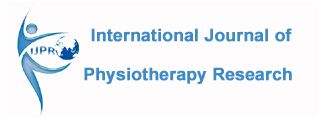IJPR.2024.124
Type of Article: Original Research
Volume 12; Issue 5 (October 2024)
Page No.: 4777-4783
DOI: https://dx.doi.org/10.16965/ijpr.2024.124
Effect of Unimanual Versus Bimanual Training on Impairment, Disability and Quality of Life Among Post Stroke Individuals: A Comparative Study
Shivangi shaileshkumar Patel *1, Jahanvi barot 2
*1 BPT intern, Nootan College of Physiotherapy, Sankalchand Patel University, Visnagar Gujarat, India – 384315
2 Assistant professor, Nootan College of Physiotherapy, Sankalchand Patel University, Visnagar Gujarat, India – 384315
Corresponding author: Shivangi S Patel (BPT intern), Nootan College of Physiotherapy, Sankalchand Patel University, Visnagar Gujarat, India – 384315 E-Mail: shivangi230202@gmail.com
ABSTRACT
Background: Stroke is a significant global health issue caused by sudden interruptions in blood flow to the brain, leading to neurological dysfunction that can result in ischemic or hemorrhagic conditions. Effective rehabilitation approaches, such as unilateral and bilateral training, play a vital role in restoring upper limb function and overall recovery through targeted neural adaptations. Evaluation tools like the (SIS) provide critical insights into post-stroke recovery and improvements in quality of life, underscoring the need for comprehensive care and early intervention in managing this complex medical condition.
Aim: To find out the effectiveness of unimanual and bimanual training on impairment, disability, and quality of life among post stroke individuals.
Study design: comparative study
Method: Firstly, ethical clearance was taken from the committee for comparative study. Samples were collected by lottery allotment sampling method. Thirty participants were selected based on inclusion and exclusion criteria. The details of the treatment were explained and written consent was taken from the participants. Experimental group treated with unimanual training and bimanual training for 5 days a week for 4 weeks.
Outcome measure: Stroke impact scale
Results: Data was analysed using SPSS Version29. According to statistical analysis, improvement seen in group B compared to group A.
Conclusions: Bimanual training showed greater effective in impairment, disability and quality of life compared to unimanual training.
Keywords: Bimanual training, Unimanual training, stroke impact scale, quality of life, stroke.
REFERENCES
[1]. Truelsen T, Begg S, Mathers C. The global burden of cerebrovascular. InWho Int 2006 (Vol. 2006).
[2]. Naqvi SJ, Sakhare N, Singh H. To compare the effects of bimanual functional practice training versus unimanual functional practice training on functional performance of upper extremity in chronic stroke. International Journal of Applied Research 2018; 4(12): 269-274.
[3]. Wilfred, Manuel G., “Exploring the Use of the Bimanual Arm Trainer for Improving Upper Extremity Motor Function in Stroke Patients.” (2019). Seton Hall University Dissertations and Theses (ETDs). 2743.
https://scholarship.shu.edu/dissertations/2743.
[4]. Mishr SS, Jose S. Effect of Resisted Bimanual Therapy With Auditory Cues on Arm Function, Balance, and Endurance in Stroke Survivors: A Pilot Study. Iranian Rehabilitation Journal. 2022 Jan 10;20:9-16.
https://doi.org/10.32598/irj.20.SpecialIssue.395.2
[5]. Richardson MC, Tears C, Morris A, Alexanders J. The effects of unilateral versus bilateral motor training on upper limb function in adults with chronic stroke: a systematic review. Journal of Stroke and Cerebrovascular Diseases. 2021 Apr 1;30(4):105617.
https://doi.org/10.1016/j.jstrokecerebrovasdis.2021.105617
[6]. Sleimen-Malkoun R, Temprado JJ, Thefenne L, Berton E. Bimanual training in stroke: How do coupling and symmetry-breaking matter?. BMC neurology. 2011 Dec;11:1-9.
https://doi.org/10.1186/1471-2377-11-11
[7]. Doost MY, Orban de Xivry JJ, Herman B, Vanthournhout L, Riga A, Bihin B, Jamart J, Laloux P, Raymackers JM, Vandermeeren Y. Learning a bimanual cooperative skill in chronic stroke under noninvasive brain stimulation: a randomized controlled trial. Neurorehabilitation and neural repair. 2019 Jun;33(6):486-98.
https://doi.org/10.1177/1545968319847963
[8]. Verstynen T, Diedrichsen J, Albert N, Aparicio P, Ivry RB. Ipsilateral motor cortex activity during unimanual hand movements relates to task complexity. Journal of neurophysiology. 2005 Mar;93(3):1209-22.
https://doi.org/10.1152/jn.00720.2004
[9]. Itkonen M, Costa Á, Yamasaki H, Okajima S, Alnajjar F, Kumada T, Shimoda S. Influence of bimanual exercise on muscle activation in post-stroke patients. Robomech Journal. 2019 Dec;6:1-1.
https://doi.org/10.1186/s40648-019-0142-1
[10]. Duff SV, Miller A, Quinn L, Youdan Jr G, Bishop L, Ruthrauff H, Wade E. Quantifying intra-and interlimb use during unimanual and bimanual tasks in persons with hemi paresis post-stroke. Journal of NeuroEngineering and Rehabilitation. 2022 May 7;19(1):44.
https://doi.org/10.1186/s12984-022-01020-8
[11]. Carod-Artal FJ, Coral LF, Trizotto DS, Moreira CM. The stroke impact scale 3.0: evaluation of acceptability, reliability, and validity of the Brazilian version. Stroke. 2008 Sep 1;39(9):2477-84.
https://doi.org/10.1161/STROKEAHA.107.513671
[12]. Mulder M, Nijland R. Stroke impact scale. Journal of physiotherapy. 2016;2(62):117.
https://doi.org/10.1016/j.jphys.2016.02.002
[13]. Klepper SE, Krasinski DC, Gilb MC, Khalil N. Comparing unimanual and bimanual training in upper extremity function in children with unilateral cerebral palsy. Pediatric Physical Therapy. 2017 Oct 1;9(4):288-306.
https://doi.org/10.1097/PEP.0000000000000438
[14]. Au KL, KnitterS JL, Morrow-McGinty S, Campos TC, Carmel JB, Friel KM. Combining Unimanual and Bimanual Therapies for Children with Hemiparesis: Is There an Optimal Delivery Schedule?. Behavioral Sciences. 2023 Jun 9; 13(6):490.
https://doi.org/10.3390/bs13060490
[15]. Van Delden AL, Beek PJ, Roerdink M, Kwakkel G, Peper CL. Unilateral and bilateral upper-limb training interventions after stroke have similar effects on bimanual coupling strength. Neurorehabilitation and neural repair. 2015 Mar; 29(3):255-67.
https://doi.org/10.1177/1545968314543498
[16]. Palomo-Carrión R, Pinero-Pinto E, Ando-LaFuente S, Ferri-Morales A, Bravo-Esteban E, Romay-Barrero H. Unimanual intensive therapy with or without unaffected hand containment in children with hemiplegia. A randomized controlled pilot study. Journal of Clinical Medicine. 2020 Sep 16;9(9):2992.
https://doi.org/10.3390/jcm9092992
[17]. Bártlová S, Šedová L, Havierniková L, Hudáčková A, Dolák F, Sadílek P. Quality of life of post-stroke patients. Slovenian Journal of Public Health. 2022 Mar 21;61(2):101-8.
https://doi.org/10.2478/sjph-2022-0014








